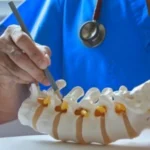Understanding the Connection Between Diabetes and Spinal Infections
Diabetes mellitus weakens the immune system, which raises the chances of spinal infections. Studies reveal that people with diabetes undergoing back procedures face a 30% infection risk, while this risk drops to 11% for those without diabetes. These numbers stress the importance of finding top-notch spine treatment by a skilled spine doctor in Delhi.

Diabetic patients face a weakened immune response, which makes infections that harm the spine more likely. Diabetes often causes microvascular disease, which reduces blood flow to spinal tissues. This poor circulation lowers the body’s ability to heal and raises the chances of infections taking hold. On top of that diabetic neuropathy can hide early warning signs, which may cause delays in both diagnosis and treatment.
Recognizing Spinal Infection Symptoms in Diabetic Patients
Finding spinal infection symptoms is key to stopping severe complications. People with diabetes need to watch for these warning signs.
- Constant Back Pain: Sharp pain in a specific area getting worse with movement
- Fever and Chills: Might go up and down and could start off mild
- Nerve Symptoms: Feeling weak or numb or experiencing a pins-and-needles sensation in the limbs
- Sudden Weight Drop: Often alongside feeling very tired
- Trouble Moving Around: Struggling with everyday tasks
Diabetic people might not notice pain as because neuropathy can hide pain signals. Seeing the best spine doctor in Delhi can help if there are any warning signs.
Diagnostic Approaches for Spinal Infections
Doctors suspecting a spinal infection in diabetic individuals, need to act and diagnose . They rely on the following methods:
Lab Tests
- Measuring C-reactive protein (CRP)
- Checking erythrocyte sedimentation rate (ESR)
- Conducting blood cultures to find pathogens
- Performing a complete blood count
Imaging Techniques
- Using MRI considered the most reliable option
- Utilizing CT scans to examine bones
- Reviewing X-rays to check spinal stability and alignment
Sant Paramanand Hospital known as one of Delhi’s leading centers for spine surgeries, uses modern diagnostic equipment. This ensures they can detect spinal infections even in complicated cases involving diabetes.
Modern Treatment Approaches for Spine Disorders
Treating spinal infections in individuals with diabetes needs a tailored plan. Dr. Amit Shridhar recognized as a Best endoscopic spine surgeon in Delhi, provides state-of-the-art care at Sant Paramanand Hospital.
Non-Surgical Care
- Using culture results to guide specific antimicrobial treatments
- Managing blood sugar levels along with providing proper nutrition
- Addressing pain and stabilizing movement when required
When Surgery is Needed
Doctors often recommend surgery in cases like:
- Extensive bone damage
- Nerve-related issues appear
- Non-surgical methods are not effective
- The spine loses its stability
Doctors now use modern methods like minimally invasive techniques to help diabetic patients. Endoscopic spine surgery, offered at the best spine surgery hospital in Delhi, has many benefits — including smaller cuts, less harm to surrounding tissues, and quicker recovery.
Injection-Free Treatment for Slip Disc: A Safer Option for Patients
To treat slip disc problems in diabetic patients, avoiding injections can be a safer choice compared to older treatments. Injection free treatment for slip disc helps because it:
- Lowers the chances of infections from injection sites
- Avoids sudden spikes or drops in blood sugar caused by steroids
- Offers lasting relief without weakening the immune system
Sant Paramanand Hospital uses endoscopic spine surgery to treat slip discs. This targets the problem itself instead of just easing the symptoms.
Comparative Analysis: Traditional vs. Modern Treatment Approaches
| Treatment Aspect | Traditional Approach | Modern Endoscopic Approach |
| Incision Size | 5-6 inches | Less than 1 inch |
| Hospital Stay | 3-7 days | Same day discharge possible |
| Recovery Time | 3-6 months | 2-4 weeks |
| Blood Loss | Significant | Minimal |
| Infection Risk | Higher (especially for diabetics) | Significantly lower |
| Muscle Damage | Extensive | Minimal |
| Post-op Pain | Severe | Mild to moderate |
| Return to Work | 2-3 months | 2-4 weeks |
Patient Experience: A Case Study
About the Patient: A 62-year-old man living with Type 2 diabetes for 15 years
Presenting Symptoms: The patient visited Sant Paramanand Hospital because of intense pain in their lower back that had been troubling them for three weeks. They also experienced fever and worsening weakness in both legs. Previous treatment with painkillers at a nearby clinic did not help at all.
Diagnosis: An MRI showed the patient had a spinal epidural abscess stretching from T12 to L3. Blood work revealed high levels of inflammation and poor control of blood sugar.
Treatment Approach: A spine expert in Delhi NCR advised treatment. The patient had an endoscopic procedure to drain and clean up the abscess. Doctors followed this with specific antibiotics chosen based on lab test results.
Outcome: The patient felt much less pain within two days after the operation. Over the next few weeks neurological function got better. The Delhi invasive spine surgery method led to a shorter stay in the hospital and quicker healing when compared to older open surgery methods.
Patient Testimonial: “I was scared to go through spine surgery because of my diabetes. The doctors at Sant Paramanand Hospital explained why the endoscopic method would be safer. My recovery went smoother than I thought, and now I can do my daily tasks without any pain.”
Prevention Strategies for Diabetic Patients
To avoid spinal infections diabetic patients need specific preventive steps. Some important ones include:
- Control Blood Sugar: Keep your blood sugar levels within the desired range.
- Visit Your Doctor Regularly: Make sure to have routine check-ups with your healthcare team.
- Treat Infections Quickly: Even small infections should be treated right away.
- Practice Good Hygiene: Take care of your skin properly in areas that could break down .
- Eat a Healthy Diet: Get enough vitamins and protein to keep your immune system working well.
Frequently Asked Questions
Q1: Why does diabetes raise the chance of spinal infections?
A: Diabetes weakens the immune system, affects blood flow to tissues through small blood vessel issues, and can hide early signs of problems due to nerve damage. These things make infections more likely and harder to detect.
Q2: Why is endoscopic spine surgery a good option for people with diabetes?
A: The procedure needs smaller cuts and causes less damage to tissues. It also results in less blood loss and shorter hospital stays. This helps reduce the chances of infections after surgery, which is important for people with diabetes.
Q3: How long does recovery take after endoscopic spine surgery to treat an infection?
A: Most people can start doing easy tasks again in 1 to 2 weeks. They often get back to their usual activities in 4 to 6 weeks. However, recovery time depends on how bad the infection is and personal factors.
Q4: Can all patients benefit from injection-free treatment for a slipped disc?
A: Many patients find it highly effective, but its success varies. Individual factors like overall health, disc condition, and the severity of the issue play a big role. To figure out the best treatment, you should consult a spine doctor.
Q5: When should I see a doctor if I think I have a spinal infection?
A: Getting medical help right away is essential. Acting helps improve recovery chances and lowers the risk of lasting nerve damage.
Conclusion
Doctors need to look at how diabetes relates to spinal infections using thorough methods to find and treat the problem. Diabetic patients facing back pain or other worrisome signs should visit the finest spine specialist in Delhi to get quick care and the best possible results.
Sant Paramanand Hospital provides modern tools to diagnose and treat these issues. They use cutting-edge endoscopic techniques that work well with diabetic needs. The hospital specializes in less invasive treatments and even offers solutions that avoid injections making it safer and more suitable for handling spinal problems in diabetic individuals.



